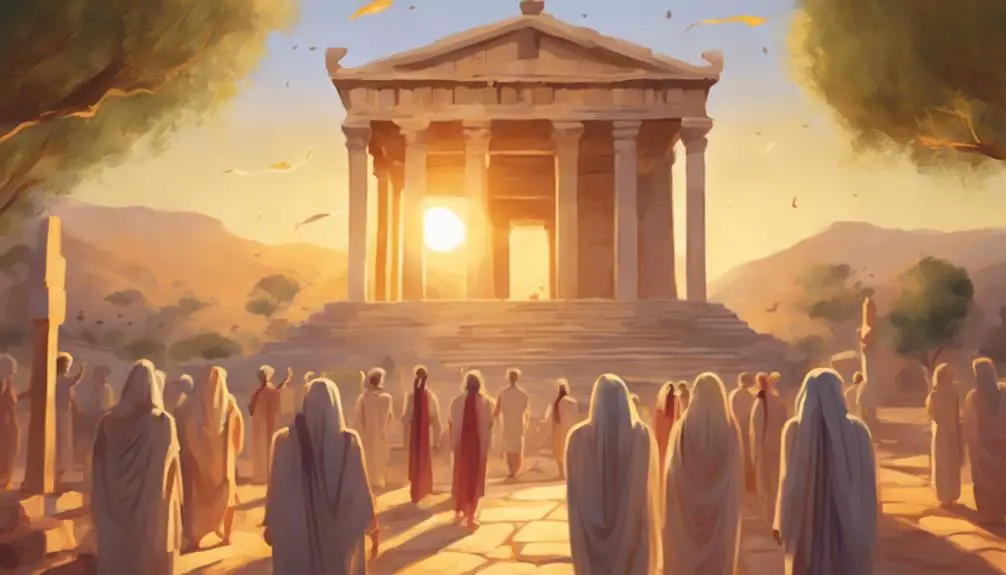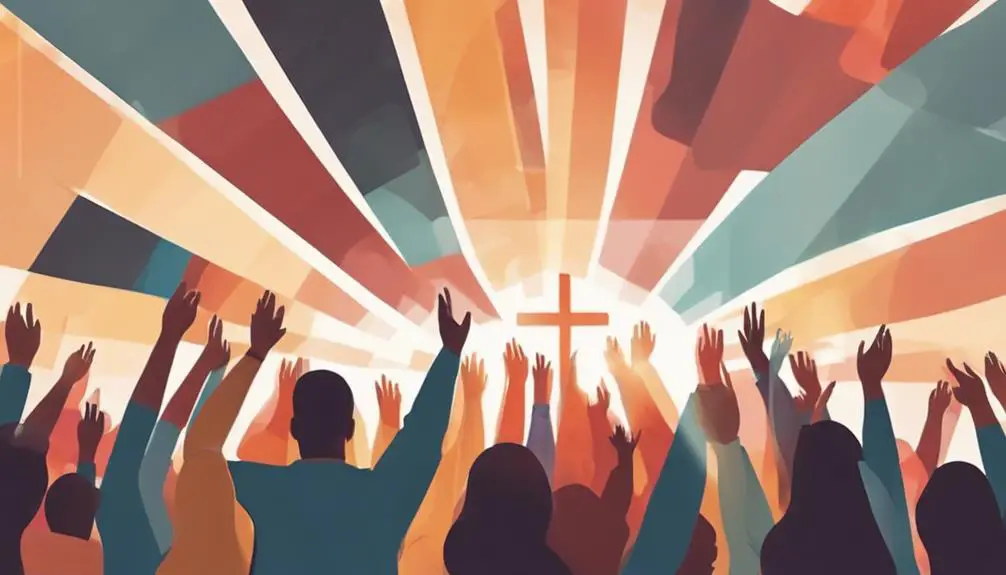Discover the captivating role of worship flags in biblical times, symbols of divine presence and unity that beckon a deeper exploration.

Worship Flags in the Bible
In the tapestry of biblical narratives, worship flags gently weave a story of devotion, marking their presence in ceremonies and battles alike. You might find it intriguing how these symbols of divine presence not only served as physical emblems but also held profound spiritual significance.
From their origins to their use in ancient worship practices, the role of banners extends beyond mere decoration. They symbolize communication with the divine, rallying points for unity and action. As you explore further, consider what these ancient practices might reveal about the nature of worship and community in contemporary contexts.
Key Takeaways
- Banners in the Bible symbolize divine presence, guidance, and collective faith in worship and battle contexts.
- Worship flags served as conduits for spiritual expression, embodying theological themes and facilitating divine meditation.
- The design and material of biblical flags reflected cultural significance, with colors and symbols conveying specific spiritual messages.
- Modern worship flags draw from ancient traditions, using color and fabric to represent different aspects of faith and spirituality.
Biblical Origins of Banners

The concept of banners, as referenced in the Bible, holds significant historical and spiritual symbolism, serving as a focal point for worship and divine representation among ancient communities. These artifacts weren't merely ornamental; they embodied the cultural significance and collective identity of the people. As you delve deeper, you'll find that banners were a powerful medium of artistic expression, intricately woven with symbols and colors that conveyed messages of faith, victory, and divine protection.
In this context, the cultural significance of these banners extends beyond their immediate visual appeal. They acted as tangible expressions of communal beliefs and values, deeply embedded in the social and religious fabric of the time. The artistry involved in their creation reflects a profound understanding of symbolism, where every hue and pattern had a purpose, communicating stories and theological concepts without words.
Through this lens, it's clear that the biblical origins of banners aren't just historical footnotes. They represent a rich tradition of expressing devotion and identity through art, highlighting the enduring link between spiritual practice and artistic expression. This intersection of faith and art offers valuable insights into the ways ancient communities celebrated their relationship with the divine.
Symbols of Divine Presence
In exploring symbols of divine presence, one finds that worship flags served as potent manifestations of God's proximity and guidance to His people. These flags weren't mere decorative items; they were imbued with deep spiritual meaning and cultural significance. Through artistic representations, these flags communicated messages of faith, hope, and divine protection. They acted as visual testimonies of God's involvement in the lives of His followers.
The use of worship flags can be seen as an early form of visual theology, where the divine is made perceptible through material culture. This practice reveals a fascinating intersection between the tangible and the spiritual, highlighting how art and symbolism can bridge the gap between humanity and the divine. The cultural significance of these flags extends beyond their immediate religious context, offering insights into how communities of faith historically perceived and experienced the divine presence.
Moreover, the artistic representations found on these flags often encapsulated key theological themes and narratives, serving as a focal point for meditation and reflection. These symbols provided a means through which the faithful could engage with divine mysteries, facilitating a deeper understanding and connection with their spiritual heritage.
Flags in Ancient Worship Practices

Delving into ancient worship practices reveals that flags served not merely as objects of decoration but as vital conduits for spiritual expression and communal identity. These artifacts bore deep cultural significance, symbolizing divine protection, guidance, and the collective faith of a community. Analyzing the flag materials and designs offers insights into the societies that created them, reflecting their resources, technological advancements, and aesthetic values.
Cultural Significance |
Flag Materials |
|---|---|
Divine Protection |
Animal Skins |
Guidance |
Plant Fibers |
Collective Faith |
Dyed Fabrics |
Societal Identity |
Precious Metals |
The choice of flag materials, ranging from animal skins to plant fibers, dyed fabrics, and even precious metals, was not arbitrary but deeply intentional. These materials were selected for their durability, availability, and symbolic meanings. For example, the use of animal skins could denote strength and resilience, while precious metals signified divine favor and splendor.
Through their vibrant colors, intricate designs, and the sacred symbols they bore, flags in ancient worship practices were not just passive emblems. They were active participants in the spiritual lives of the communities, serving as focal points in ceremonies and tangible reminders of the unseen divine.
The Role of Banners in Battle
Throughout history, armies have utilized banners not only to organize their forces but also to inspire soldiers and intimidate opponents during battle. These flags served as more than mere symbols; they were integral to military strategy and played a crucial role in the psychological warfare of enemy intimidation. Here's how:
- Visual Coordination: Banners allowed commanders to direct troops across the chaos of battlefields, serving as reference points for maneuvers and formations.
- Morale Boosting: Carrying the colors of one's nation or leader into battle bolstered soldier morale. Seeing their banner flying high provided psychological assurance and a sense of pride and unity.
- Enemy Intimidation: The size, number, and appearance of banners could intimidate opposing forces. A display of numerous, elaborately designed banners signaled strength and the favor of divine powers.
- Symbolic Representation: Flags often bore symbols or emblems signifying divine protection or the righteousness of their cause, reinforcing the belief in their destined victory among troops.
In essence, banners weren't merely decorative. They encapsulated elements of military strategy and psychological warfare, significantly impacting the outcomes of historical battles through both direct coordination and subtler means of morale enhancement and enemy intimidation.
Modern Interpretations and Uses

Having explored the historical significance of banners in battle, we'll now examine how modern interpretations and uses of worship flags reflect both continuity and evolution from their ancient counterparts. Today, the use of worship flags in religious and spiritual contexts often involves a deliberate choice of colors and fabrics, each signifying different aspects of faith and spirituality.
Color significance plays a pivotal role in the design of modern worship flags. For instance, blue often represents heavenly grace, while red may symbolize the blood of Christ or the Holy Spirit's fire. This conscious selection of colors serves not only as a visual tool for worship but also as a means of theological expression, connecting the physical act of flag waving with deeper spiritual meanings.
Fabric choices, too, are carefully considered, with different materials chosen for their specific qualities. Silk, for example, is favored for its fluid movement, symbolizing the Holy Spirit's gentle yet powerful presence. Lightweight polyester is another popular choice, appreciated for its durability and vibrant color display. These choices reflect an understanding of how the tactile and visual qualities of the flags can enhance the worship experience, bridging the gap between ancient symbols and contemporary spiritual practice.
Frequently Asked Questions
How Do Different Christian Denominations View the Use of Worship Flags in Contemporary Church Services?
You'll find that denominational acceptance of worship flags in contemporary church services varies widely. Some denominations embrace them, seeing flags as a powerful expression of faith and worship.
Others are more cautious or outright reject their use, due to interpretative variation in scripture or tradition. This division often reflects deeper theological and liturgical differences.
Ultimately, your experience with worship flags will depend greatly on your denomination's stance and its approach to worship practices.
Are There Specific Colors of Worship Flags That Are Recommended for Certain Liturgical Seasons or Religious Celebrations?
You're curious if there are recommended colors for worship flags during specific liturgical seasons or religious celebrations. Indeed, color symbolism plays a crucial role in conveying the spiritual message.
Seasonal appropriateness guides the selection, aligning colors with the church calendar to deepen worship experiences. For example, purple is favored during Lent for its penitential meaning, while white symbolizes purity and joy during Easter and Christmas, reflecting the season's thematic essence.
How Do Worship Flags Differ From Other Religious Symbols Like the Cross or Candles in Terms of Spiritual Significance?
As the adage goes, 'A picture is worth a thousand words,' so too does flag symbolism in religious contexts convey profound spiritual meanings.
Unlike other religious artifacts such as the cross or candles, which directly symbolize Christ's sacrifice or the light of God, worship flags often carry broader, more interpretive spiritual significance.
They can embody a range of divine attributes, from victory and warfare to peace and sanctity, offering a unique, dynamic form of expression.
Can Individuals Use Worship Flags in Their Personal Prayer Time, and if So, Are There Guidelines on How to Properly Incorporate Them?
Yes, you can use worship flags during your personal prayer time, allowing for a unique expression of faith. There aren't strict guidelines, but understanding flag maintenance ensures their longevity.
Your personal interpretation plays a crucial role in how you incorporate them, reflecting your spiritual journey. It's about connecting deeper with your beliefs, letting the flags serve as an extension of your devotion.
What Are the Historical and Cultural Influences on the Designs and Patterns Commonly Seen on Modern Worship Flags?
You're exploring how historical and cultural influences have shaped the designs and patterns on modern worship flags. These flags' fabrics and aesthetics have evolved significantly over time.
Initially, flag materials and design evolution were deeply intertwined with the cultural and religious contexts they emerged from.
Today's patterns often reflect a blend of ancient symbols and contemporary artistic expressions, showcasing a rich tapestry of tradition and innovation in their creation and use.
Conclusion
Ironically, while ancient texts and practices weave an elaborate tapestry of banners symbolizing divine presence and victory, today's worship flags often flutter more as decorative afterthoughts than as potent symbols of faith and divine intervention.
Despite their rich biblical origins and significant roles in ancient worship and battle, modern interpretations and uses sometimes reduce these once-majestic symbols to mere accessories.
This divergence highlights a curious shift from the deeply symbolic and functional to the aesthetically pleasing yet potentially superficial in contemporary spiritual practices.



Sign up